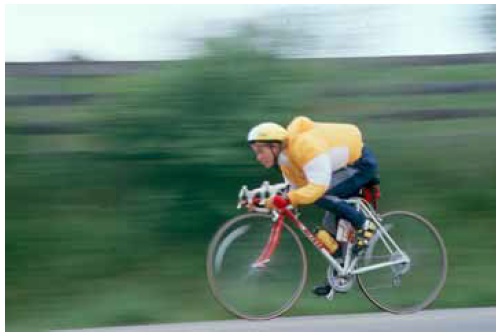Design Speed
The selected design speed of a facility affects many aspects of geometric design. Consequently, it can significantly impact the cost, constructability, and operational safety of a project. The AASHTO Guide for the Development of Bicycle Facilities (p. 36) specifies 30 km/h (20 mi/h) as the minimum design speed that should be used on shared use paths (figure 47).(2) It goes on to provide modifiers for grades and strong prevailing winds.

Figure 47. AASHTO's design bicyclist travels at 30 km/h (20 mi/h).
(Photo by Dan Burden.)
Of the bicyclist participants in this research project, only four, or 1 percent, exceeded the suggested 30-km/h (20-mi/h) design speed. The 85th percentile speed for bicyclists was 22 km/h (14 mi/h). This suggests that the 30-km/h (20-mi/h) design speed may be conservative; however, further research is needed.
Recumbent bicyclists had the highest observed 85th percentile speeds, 29 km/h (18 mi/h). This may suggest that they may be the appropriate user upon which to set a minimum design speed. However, as discussed in the following sections, the additional design characteristics of the various users need to be evaluated before such a conclusion can be drawn.
At the other extreme, hand cyclists appear to have the lowest 15th percentile speed, 8 km/h (5 mi/h), of those users who would be expected to operate in the street. Strollers had the lowest 15th percentile speed, 4 km/h (3 mi/h) (table 12).
2. American Association of State Highway and Transportation Officials. Guide for the Development of Bicycle Facilities. American Association of State Highway and Transportation Officials, Washington, DC, 1999.

User Comments/Questions
Add Comment/Question